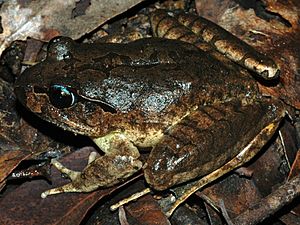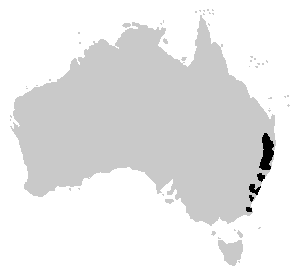Stuttering frog facts for kids
Quick facts for kids Stuttering frog |
|
|---|---|
 |
|
| Conservation status | |
| Scientific classification | |
| Genus: |
Mixophyes
|
| Species: |
balbus
|
 |
|
| Stuttering frog range | |
The stuttering frog (Mixophyes balbus) is a large type of frog. It lives in cool and warm rainforests. You can also find it in wet sclerophyll forests in Australia.
Contents
Where the Stuttering Frog Lives
This frog used to live in a very large area. Its home stretched from the Timbarra River in northern New South Wales. It went all the way to the Cann River in eastern Victoria. This area was about 110,000 square kilometers.
Sadly, many stuttering frogs have disappeared. Populations south of Sydney have shrunk a lot. Frogs in Victoria are thought to be completely gone. They have also vanished from places in New South Wales where they used to be common.
Stuttering frogs live at different heights. They can be found from 20 meters up to 1400 meters high. In the northern parts of their home, they only live in high places. But in the south, they live in both high and low areas.
What the Stuttering Frog Looks Like
This frog can grow quite big. It can be up to 80 millimeters long. That's about the length of a credit card!
Its back is brown. This color slowly fades to a pale yellow on its belly. It often has a dark, uneven blotch. This blotch starts between its eyes and goes down its back. Sometimes, it looks broken up.
The frog also has a dark stripe on its head. This stripe starts as a triangle before its nose. It then goes from its nostril to its eye. From the eye, it continues over its ear (called the tympanum). It finishes over its shoulder. The tympanum is a bit oval-shaped and easy to see.
The frog's iris (the colored part of its eye) is special. It is light blue at the bottom. This blue blends into gold above its pupil. Below the pupil, it is dark brown. Its back legs have faint bars, usually 4 to 6 of them. Its toes are about three-quarters webbed. Its fingers do not have webbing.
Life and Habits of the Stuttering Frog
This frog likes to live near flowing creeks and streams. It lives in cool and warm rainforests. It also lives in wet sclerophyll forests and Antarctic Beech forests.
The male frog makes a special call. It sounds like "kook kook kook kra-a-ak kruk kruk." This call lasts one to two seconds. Males call while next to the stream, often on fallen leaves.
The female frog lays her eggs (called spawn) in nests. These nests are dug out in shallow, flowing water. They are made of gravel.
The baby frogs, called tadpoles, are usually 65 millimeters long. Some can even reach 80 millimeters. Tadpoles are dark brown or black. They have large spots and flecks on their tail.
It can take a long time for a tadpole to change into a frog. This change, called metamorphosis, can take up to 15 months. Young frogs look a lot like adult frogs. But their back patterns are not as clear. Their eyes have a rusty red iris.
How to Tell it Apart from Similar Frogs
The stuttering frog is unique. It has a blue crescent shape in the upper part of its eye. This helps tell it apart from most other Mixophyes species.
However, it looks very similar to Mixophyes fleayi. You can tell the stuttering frog apart from Mixophyes fleayi because it does not have blotchy patterns on its sides.
See also
 In Spanish: Mixophyes balbus para niños
In Spanish: Mixophyes balbus para niños


